It was a special moment.
As we soared past the peak of Kilimanjaro with the evening glow and the peak shrouded in mist, I had a major rush of adrenalin from the thought of modern humans having originated in the rift valley millions of years ago.
There was also a personal feeling. I was travelling to the Island of Zanzibar in the Indian Ocean.
I was to spend two months with a charity teaching the local workforce how to speak English. It was to be the best two months of my life…
As the car bounced along the unpaved mud road into the local village where we were posted, Jambiani, the taste of Zanzibar truly bloomed.
The water shimmered bluer than turquoise itself, the palm trees spreading their giant shadows over the white beaches. The beaches had been bleached by the sun for eternity and the locals were full of smiles.
“Jambo”, they’d say. “Jambo”, I’d reply.
Our billet was a comfortable little set of rooms called “Grand Bungalows”. One had to only open the back gate and they were on the beach, where most of the locals would ply their trade selling ornaments and food.
The project was located at a place called Jambiani Tourism Training Institute. The course was designed with employment in the tourism industry in mind.
It was free for the students to join and they would be awarded with a certificate if they advanced past level five. This meant that they would receive an official qualification for the course.
The volunteers were great people and I could not have asked for more help from them. We were paired off and asked to work together for the one-and-a half-hour period that we taught in the mornings.
The lessons were designed so that the students could be taught how to use the language in a context that would be useful to their place of work and also to the tourists they serve.
This is not difficult to define. Whilst this practical reason for learning the language does not limit the students from becoming proficient in English and using the language to further their social lives, it is not the main aim.
The students were a joy to work with. Their enthusiasm shone through with flying colours and their performance soared. This might not be surprising given that I was teaching level 5, the highest grade.
Nonetheless, it was truly inspiring to watch their confidence grow.
There were only five students in that level and, owing to the relaxed nature of the programme and its free admittance, we could not expect a complete group on a given day.
This was always an interesting point…never knowing who was going to turn up.
How about a little bit of background to this trip. I’m sure some of you reading this are wondering how much this cost. Which vaccinations are required?
What was the charity’s name? Ok, here are a few details on the project.
The cost for every two weeks is £895 and a £180 deposit is required. Your pick-up from Zanzibar Airport or ferry port on arrival and departure is included, as is all site and project orientation, catering and laundry.
You’ll need to be thick-skinned though. You’ll also have to take malaria pills every day.
The shots will be for Yellow Fever, Tetanus and other diseases, the details of which may be provided to you by your parent charity or, in my case, the agency through which I booked.
Prepare to shell out for the injections. These, for me, costed between £50 to £130. However, this is offset by the fact that, frequently, more than one disease will be immunised with a single injection.
There are a few things to bear in mind about Zanzibar. It is Muslim and it would be prudent to check on the religious dates of such festivals as Ramadan. My stint was during this period, but I did not find it a problem.
The rules regarding this religion are nowhere near as stringent as, say, a Middle Eastern Nation. The dress code is relaxed. One must wear trousers that stretch below the knee and shirts with arms beyond the elbow.
No problem. You’ll want to have loose clothing anyway and the average temperature at any given time is nowhere above 30 degrees celsius. As for the alcohol rules, these are not stringent. Just avoid public places.
Some of you may have heard some rumours or read bad press about the Island. Namely, an incident where two volunteers had acid thrown in their face.
Don’t let this put you off. Mind you, if you really want to do this, you won’t be adverse to it.
Tanzania is a vast country and many exciting adventures will take place during your adventure such as the Dolphin-swimming, the monkey sanctuary and the spice tour.
These adventures entail being offshore in the Indian ocean, meeting cute, furry creatures and explosive taste.
My favourite was the Dolphin swimming. The thought of having these beautiful creatures amongst our kind. They are GORGEOUS!!
The sharks are kept away by the tourist boats circling around and wont dare come near. The Monkeys are really cute! Their furry faces are adorable and they peer at you through the trees.
And one may come close enough to snap a rather nice album shot. Swinging from tree to tree, these creatures will win you over in no time.
Stone Town is a UNESCO World Heritage Site and should be kept that way. It has a stunning church with a sad history and a slave chamber beneath it.
The famous night market will whet your appetite with falafel and spicy potato and sugar cane juice. Wow!
The waterfront here is amazing and the most spectacular sunsets, as vivid as a blood orange, descend over the westerly horizon. At this latitude, you will have only a few minutes. But they are truly worth your time.
You can also sit by the waterfront, where the night market already is, with the sun in front of you, the green and open Forodhani Gardens behind and the old Sultan’s Palace, now the museum of Zanzibar, still further behind.
What an Island!




